Don't wanna be here? Send us removal request.
Photo
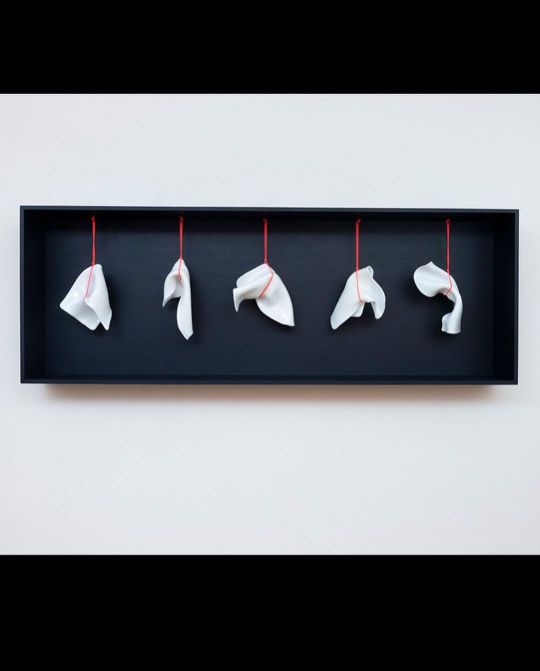
Excellent news - 5 Days of Falling has been selected for the British Glass Biennale 2022 (Stourbridge, Aug-Oct). Made during the beginning of lockdown, without a hope of showing it any time soon, the technical challenge of folding the glass was probably good therapy. Obsessed with the properties of gravity, I was driven to make this piece in spite of its length (storage alert). So it’s particularly satisfying that it will see the light of day at the most prestigious glass event in Britain. Thank you to the judges for their adventurous spirit! Note: the piece references the astronauts on the ISS who are constantly falling, little did I know I’d have an artwork on their spacecraft two years later 👩🚀 #britishglassbiennale #glassslumping #sculpturalglass #kilnformedglass #installation #contemporaryart #wallsculpture #artinstallation #new_and_abstract https://www.instagram.com/p/CcPeo8xMhBk/?igshid=NGJjMDIxMWI=
#britishglassbiennale#glassslumping#sculpturalglass#kilnformedglass#installation#contemporaryart#wallsculpture#artinstallation#new_and_abstract
4 notes
·
View notes
Photo

A satisfying morning at MSSL Space Lab creating an important piece of space art! The Fingertip Galaxy artwork plaque was laser etched on to a treated aluminium sheet that will be fixed to the ESA’s Euclid Mission spacecraft later this month. Over 250 scientists and engineers put their painted fingertips on to a giant artwork symbolising the many personal contributions to the mission and the spirit of the endeavour. Lines from a commissioned poem by Simon Barraclough are included around the artwork. I’ll be attending a press launch in Italy with Euclid science lead Tom Kitching where we’ll read the full poem. @samcharlesworthfilms recorded the process (inc putting the camera inside the laser unit!) and is creating a film about the making of the artwork and plaque. The Euclid mission will map dark matter structure and study dark energy by imaging distortions in billions of galaxies and will launch in 2023. #spaceart #euclid2020 #esa #galaxies #collaboration #artscience https://www.instagram.com/p/CbaaZJgMeks/?utm_medium=tumblr
0 notes
Text
Art in Space: Meaning and potential

A few months ago, I received an exciting email notification – my submission to the Moon Gallery ISS Test Mission was successful and my tiny sculpture called Verdant would be travelling to the International Space Station in February 2022. Gulp. Until that moment, I hadn’t grasped the astonishing significance for my art practice and, as the weeks have passed, the realisation of the significance of placing art in space or on another planetary body. How should society feel about such initiatives, do they have meaning for humankind?
Aiming for the moon
Before I go into more detail about my contribution, let’s start with the Moon Gallery Foundation that has proposed the mission. Based in the Netherlands, its directors are connected to the European Space Agency and their long-term aim is to place a permanent gallery on the moon, hopefully as early as 2025. Through an open call, 100 artists will be selected for this extraordinary gallery, its walls a clear acrylic grid of 10, 1cm square spaces housing 100 mini artworks.
The logistics of sending this precious package safely to the moon warranted a test mission exploring the artistic and technical possibilities of the concept, so the group devised a mission to the ISS. My piece was among those created by 64 artists selected for the test mission (I simultaneously became a candidate for the eventual gallery on the moon). A container made by space payload consultants Nanoracks will house the gallery and record its movements via video while it floats in the famous ISS cupola window. The astronauts are free to interact with the gallery and we are hoping to record their responses.
What attracted me to the competition was the ethos of the Moon Gallery: to include art and culture alongside the scientific and technical aspirations of space exploration, and to encourage interdisciplinary cooperation. As a graduate of the Central Saint Martins MA Art and Science course (2018), I’m an advocate of art/science collaborations and this approach is at the core of my art practice. In 2019 I completed a residency at Mullard Space Science Laboratory (part of University College London) where I followed the ESA’s Euclid Mission and investigated concepts around dark matter and our changing perception of the universe.
Living with green
Verdant is a response to imagining interplanetary travel to worlds bereft of the life-giving colour green abundant on our luscious planet. Based on the central structure of the chlorophyll molecule (1 magnesium + 4 nitrogen atoms), four green glass beads are tethered to a larger clear bead via fluorescent green threads. I was particularly interested in creating a sculpture sensitive to weightlessness and light – how would its little arms move while on the ISS and how would the unfiltered light of space interact with the glass? In this way, the artwork is experimental, providing an aesthetic understanding of sculpture in microgravity environments. Also, the moon (and Mars) are stark, rocky places with distinctly limited colour pallets and I’m curious how settlers will react to living long periods without the visual freshness of plant life. The green spectrum is part of a bigger concern for our home planet: we are rapidly destroying our most precious wild places through deforestation and encroaching human habitats. The sculpture is bound up with that prospect too.

The humanities in space
Of course, science and technology are investigating earthly dilemmas through, for example, satellite technologies but art has a role to play in identifying the emotional qualities of our relationship with nature and, from the vantage point of space, a unique stage is set to examine these responses. The gallery has the potential to spark vital conversations from a unique perspective. Hopefully if enough people ‘watch’ the exhibition, it’ll prompt discussions (amongst the astronauts and at home) and find new audiences for art via space-keen viewers. Art is the glue joining disparate parts of society, binding them together through self-expression. It can help us unravel the harsher aspects of living and is certainly capable of parsing our sticky relationship with technology and nature.
Creative objects abound in sophisticated civilisations so why not take them to space too? I was reminded of this recently when Roman statues were discovered in Buckinghamshire in the UK during excavations for a new railway route (HS2). And last week I saw a beautiful Roman mosaic floor adorning a recovered Roman Villa in Dorchester. The British Isles were once a brave new world for the Romans and they civilised their dwellings with art and design objects. Creative expression has always travelled with explorers and as such we should bring the best of humanity into space.
As I await the tantalising launch of the NG-17 resupply mission to the ISS in February carrying the Moon Gallery’s artefacts, I can’t help but think that a new era of art making is upon us. Others have been there before but perhaps a momentum is building alongside the current push into space. In 1969 Robert Rauschenburg was among a group of artists (including Andy Warhol) who surreptitiously left their marks on a Simm-sized ceramic chip fixed to the leg of the lunar lander* and taken to the moon on the Apollo 12 mission. Many others have since followed with the same goal – sending art representing the human condition into space. When preparing such artworks, artists are necessarily required to think differently, to consider the context of their idea. Expansive concepts can evolve in the process: how does one distil the human voice and experiences to the world and potentially to other life forms in the universe?
Incredibly, I have another space related artwork launching in 2023. A project developed with Prof Tom Kitching (UCL) during the residency at Mullard Space Science Laboratory, this artwork was a collaboration with over 250 Euclid Mission scientists and engineers. The Fingertip Galaxy was produced using their painted fingertips creating a large galaxy drawing and was made at the international consortium conference in Helsinki 2019 with ESA’s assurance that it would be included on the spacecraft. In discussions with Tom, I noted that the Euclid spacecraft design didn’t entirely reflect the humanity that built it. There are over 1,500 people working on the mission worldwide. For many of them space exploration is a passion and their meaningful contributions transcend the science and technology. The Euclid telescope will record and map the furthest galaxies known to science, so we devised a project to express the collective desire to ‘touch space’ in the spirit of curiosity and wonder. Currently, we are designing a small aluminium artwork plaque that will be fixed to the payload structure this spring. Working with poet Simon Barraclough, we’ll integrate a short poem, giving it additional context and meaning for those who might find it in the millennia to come. These two space artworks have altered the scope of my understanding of what art can accomplish.

Prof Tom Kitching and Lisa Pettibone in front of the Fingertip Galaxy artwork heading for space aboard ESA’s Euclid Mission in 2023, copyright Lisa Pettibone
If you’d like to know more about the Moon Gallery and/or make a donation to the project, follow the link below (they also have great merch!). My work with MSSL Space Lab (including a film) can be accessed via my website (link below).
http://www.moongallery.eu/
https://www.pettibone.co.uk/mssl-space-lab-residency
*https://www.artsy.net/article/artsy-editorial-how-warhol-rauschenberg-and-chamberlain-smuggled-art-onto-the-moon
2 notes
·
View notes
Text
Switching On
Over the last six months it’s safe to say that, with the exception of pandemic distractions, I’ve continued to process the ideas from the MSSL Lab residency. It was never meant to be tucked away as ‘job done’, impressions linger. Interests in form, light and concepts of matter as seen through the lens of space science continue to spark ideas. I’m still asking how we are meant to imagine invisible matter and in fact, what does this suggest? We can’t even see the smallest believable forms of matter (electrons) so the realm of dark matter is a clear breach of imagination. Perhaps this is why I’m drawn to the certainty of rocks – rocks I can hold in my hand. Recently I gathered a handful from Lancing beach and I put them on surfaces around the house, randomly clasping them, weighing up their realness and inspecting their negative spaces.

I’m conscious of a trend developing in my sculptures and collages – stark form with fluorescent thread jutting through the shapes, both connecting and dividing spaces within. The thread emits light and challenges perception about its nature. This assertive red line has a vibrational quality I’m enamoured with and is emerging as a signature connecting many works. In astronomy, the path of light is essential - the precursor of looking, sensing, understanding. Light = understanding. The thread becomes a thin searchlight, exploring spaces as new views are reveal from different angles. Most of my new pieces can be placed in several positions, meaning there isn’t one point of view and indicating that searching itself is what’s important. It involves the viewer in choosing the perception of the piece.

Opening 1, glass and thread
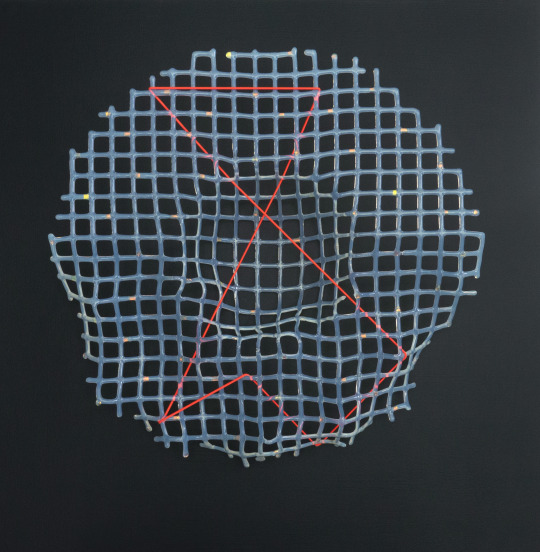
Confound, glass and elastic cord

Confound detail
Thread is a metaphor for connection too. Sitting and learning from astrophysicists at the lab I was aware that they are attempting to string together a series of connections or parts of a whole. Why are galaxies shaped so distinctly, what has made them that way, what does it say about the hidden forces stroking their ghostly forms? The instruments they build are like arrows in space finding a place to land: light gathered at unfathomable distance will release a tiny amount of information to study.
Always interested in the evolution of form, recent artistic research has lead me to investigate galaxy shapes, both their aesthetic qualities and scientific significance. The spiral shapes are particularly interesting – no other objects in space indicate movement so distinctly. We recognise this in earthly forces too, when we stir two liquids like cream in coffer together or watch soapy water go down the drain. Instinctively we understand the forces involved.
To this end, I’ve been participating in Galaxy Zoo, an online citizen science tool helping to identify the unique characteristics of galaxies: fuzzy elliptical puffs, swirling spiral arms, misshapen blobs indicating cosmic collisions. The sheer variety of shapes is staggering. The Euclid Mission will add millions of these images to the pile to be studied from 2022 so ESA is funding research into a catalogue system involving AI. However, the human eye is better at recognising the subtle differences than AI bots (well done OUR instrument) so human intervention is still needed.
I’ve also had a Zoom meeting with Ralph Schoenrich at MSSL (UCL) who is studying galaxy morphology and he generously shared his research into the internal structures of these phenomena. He believes that our star (perched on the outer edges of the Milky Way) originated elsewhere and migrated to its present position. The Sun is caught up in a kind of pocket of stars rolled together within the galaxy a bit like blobs of milk formed within a cloud of water (my comparison not his). The diagrams in his paper reminded me of the sort of patterns seen in fluid dynamic images: forms within forms pinched between competing forces. He also described how dark matter might have influenced this iconic form by herding matter together over time.
I find it curious how important shape is to science and, though it’s not clear where I will go with this research, I feel compelled to pursue it. Instinctively I sense a connection between the human need to categorise form and the aesthetic qualities we attach to shape.
0 notes
Photo

Processes: screen print Found Missing started as a collage using a print out of a Photoshop gradation I combined with laser copies of meteorites. The Widmastatten pattern (inside some meteorites) are created as nickel/iron chrysalises over millions of years, a wonderful representation of time. In the end I ditched this aspect when I was more drawn to the shape of the meteor and wanted the emphasis on the background texture (ESA’s synthetic universe) and a sense of missing information.The double horizon also implies aspects of time. There is fluorescent red in the pink ink - the colour palette took a while to perfect and were influenced byJapanese wood block prints. Developed @ochreprint then finally the edition of 12 were printed @jealous_london . . . #timeandspace #artandscience #blendingcolors #meteorites #screenprinting #collage #data #contemporyart #sciart https://www.instagram.com/p/B-czGFhFtEr/?igshid=5prro8t2hjid
#timeandspace#artandscience#blendingcolors#meteorites#screenprinting#collage#data#contemporyart#sciart
0 notes
Photo

The experimental process I work through, on the way to a final piece, is the most enjoyable part of being an artist. Using a large theatre style fresnel light, I played with different gels while searching for a certain rear projection effect. Pushing light through contorted glass was so absorbing. Sorry to finish Truth Through Illusion, could have kept going... #theprocess #artjourneys #intheflow #fresnellight #illuminatedglass #illusion #experiment #emergingform #darkmatter #distorted-light https://www.instagram.com/p/B-Gnt5zFVOo/?igshid=3ozworyirbkk
#theprocess#artjourneys#intheflow#fresnellight#illuminatedglass#illusion#experiment#emergingform#darkmatter#distorted
0 notes
Text
Bringing Science to its Senses
Winding up the residency at MSSL Space Lab
It’s taken a few months to digest the experience of being artist-in-residence at Mullard Space Science Laboratory following the Euclid Mission. Reflecting on the multi-layered project I had planned, I asked myself what were the significant outcomes, both in terms of an art/science initiative and the artwork it inspired? Working from September 2018 to September 2019, the aim was to respond to this European Space Agency-led mission through sculpture and print while running a series of creative workshops for the lab staff based in rural Surrey. With funding from Arts Council England, I was able to record this journey on film, documenting the process of integrating philosophical and technical research into a body of work that has effectively crystallised my practice.
Initially I was interested in how the Euclid Mission would alter our perception of the universe as it searched for answers about dark matter and dark energy by mapping billions of galaxies three-quarters back in time to the Big Bang. MSSL are producing the VIS (visible light spectrum) instrument on the 1.2 metre wide telescope destined to be the largest camera in space when it launches in 2022. Peering into the deepest reaches of the cosmos, it will provide a fresh perspective on the evolution and structure of the universe while testing Einstein’s theories about gravity on a cosmological scale.
Admittedly, the complexity of the mission was difficult to take in. The first four months were spent interviewing most of the members of the Euclid team at MSSL (about 13 scientists and engineers) to understand the instrument better through their varied roles. Alongside this, I was invited to watch testing in laboratories and clean rooms as well as component making in engineering workshops. The technical aspects of space science are fascinating – materials, optical experiments, electrical components and the physical quality of the laboratories are at once dazzling and surreal for an outsider. At times there was a dizzying amount of information to take in and I needed to retreat to the library to make notes, little drawings or process thoughts while taking in the idyllic scenery of Holmbury St Mary in the Surrey Hills. In this beautiful and surprising setting for a space science facility, I became convinced the surroundings contributed to the openness and well being of lab staff.
The wood-panelled common room, which adjoins many key areas of the lab, became my base and de-facto meeting room. It was the perfect spot for me, with a wide-ranging selection of science magazines to dive into and where, between meetings, I was able to conduct impromptu conversations with anyone passing through to the canteen or labs. As time progressed these conversations became more friendly and varied – one minute I was learning about plasma physics and the next I was being shown holiday sunset snaps. To be honest, most days I left buzzing with energy and enthusiasm.

From the beginning two things struck me: the enormous amount of data that would be generated via the instrument and the levels of calibration the naked light to which the universe would be subjected after it is collected by the camera CCDs. These areas of interest gradually influenced related personal research and the development of visual responses to experiences at the lab. Alongside these ideas, investigating the concept of dark matter prompted questions about how we were to grasp a new sense of materiality: dark matter is invisible, doesn’t reflect light, is non-luminous yet its mass produces gravity capable of creating structure in the universe. As someone involved with materials and light this was enormously exciting.
The light passing through the VIS instrument will go through about 20 levels of calibration after being transmitted to ground stations for processing. This scrubbing of visual data stimulated questions about what we chose to see and, in turn, to perceive. Photons, travelling billions of years, will be detected on highly polished silicon surfaces showing us faint galaxies formed near the beginning of the universe. The processing of this data will eliminate unwanted information such as cosmic rays streaking though the image which often obscure the field of view. I began to question the purity of the technological viewpoint and turned my thoughts to the construction of perception from a philosophical point of view. This research centred on the writings of Maurice Merleau-Ponty (1908-1961) and quantum physicist/thinker David Bohm (1917-1992). I felt it was important to consider the basis of ‘looking’ itself. The root of observation, essential for artists and scientists, conscious sight is a supremely human sense. Where and how we chose to gaze at our environment dictates much of what we actually see, eventually emerging as thought and, later, knowledge.
In the essay Eye and Mind, Merleau-Ponty (see previous blog Searching the Sky) states that the body is the primary site of all perception. Before we think, we sense. Light, sound and touch are experienced through the human senses that feel the world viscerally before analysing or finding meaning in the sensory. He identifies this primary stage as particularly relevant to artists, claiming that by ‘lending his body to the world’ an artist embodies sensation and meaning by conveying a visual record in his materials. He suggests that science should return to this original state of sensory experience to properly ground thought and move away from seeing the body as ‘an information machine’. I realised that, inadvertently, I had been touching on this through the creative workshops for the scientists. Arranging granules of glass for fusing, layering imagery for cyanotype prints and bending paper sculptures were all extremely tactile activities where eye and mind come together. As an add on to a pinhole camera workshop with artist Olga Suchanova, we constructed a camera obscura in a meeting room, inviting staff to experience the optical phenomenon in darkness. I remember standing with the Euclid instrument, scientist quietly waiting for our eyes to adjust to the fine light piercing through the paper hole. As the inverted image the image of trees and sky gradually appeared on a white board, we remarked on how extraordinary it looked. This comment was from someone who is constructing the most powerful camera in space. For a moment we were hyper-aware of the experience of seeing (see previous blog Sensing).
As the development of my artwork progressed, the words of David Bohm began to influence thoughts and the manipulation of materials. Bohm was interested in how paradigms occur and described perception as a feedback loop of sensory information, abstract analysis and re-testing of our environment. We build up a structure of reality based on consistent experiences. New information disrupts the construction of established paradigms causing science (and the public) to re-see reality. And once we understand a new concept, it is impossible to the original perception in the same way. Our ‘inner show’ depicting reality is suddenly altered. Ever drawn to the properties of illusion and thinking about dark matter, I began to experiment with projecting light through bent glass, casting moving 3D shadows on a studio wall. I recognised this type of perceptual shift in my work: the difference between the physical reality of the glass and the illusory forms of the projection. ‘Truth in Illusion’ became a theatrical installation poking at our reluctance to release old paradigms and reinforce instincts to let fresh information alter assumptions.
The sensory, filtering data and concepts around blind spots threaded through much of my work for the end of residency exhibition at Lumen Gallery in October 2019 (https://www.pettibone.co.uk/mssl-space-lab-residency). The central installation ‘Cosmic Landscape’ explored our expanding view of the universe through the aims of the Euclid Mission in ten metres of fabric and glass. Screen print ‘Found Missing’ relates to the conundrum of dark matter and looking for the invisible. ‘Enfolding’, a lustred glass sculpture, nods to Bohm’s reference to an ‘enfolding and unfolding universe’ and the two-dimensional experience of viewing the night sky. Lab data emerged in several pieces including ‘The Language of Light’ photomontage series where astral data, used to test the VIS instrument, is combined with views from Lizard Point in Cornwall.

Found Missing, screen print, edition of 12
I can honestly say the work genuinely reflects my experience of working so closely with MSSL Space Lab and the Euclid project. The slow burn of continuing ideas, and desire to share this art/science initiative, indicates that the residency will affect me for a long time. ESA have invited me to speak about my involvement with the mission at their headquarters in the Netherlands in February 2020, so perhaps interest in the science sector is growing. It remains to be seen how the lab has been affected: the workshops were well attended and garnered many positive comments and Dr Tom Kitching*, who hosted me, was enthusiastic throughout. I write this as I prepare for a final presentation at the lab tomorrow where I’ll unveil the film I made with Sam Charlesworth and a selection of artwork. Perhaps the experience will be a slow burn for them as well.
*As a side project, I collaborated with Tom to devise a collaborative artwork titled ‘Fingertip Galaxy’ made by over 250 scientists and engineers at the annual Euclid Consortium Meeting held in Helsinki in 2019. Representing the spirit of the mission, ESA have committed to placing the artwork on the spacecraft when it launches in 2022. (See previous blog Touching Space.)
#artscience#artistinresidence#euclidmission#artexhibition#darkmatterart#cosmiclandscape#space science#perception#philosophy#sensoryexperiences#sensoryscience#astrophysics#seeing
0 notes
Photo
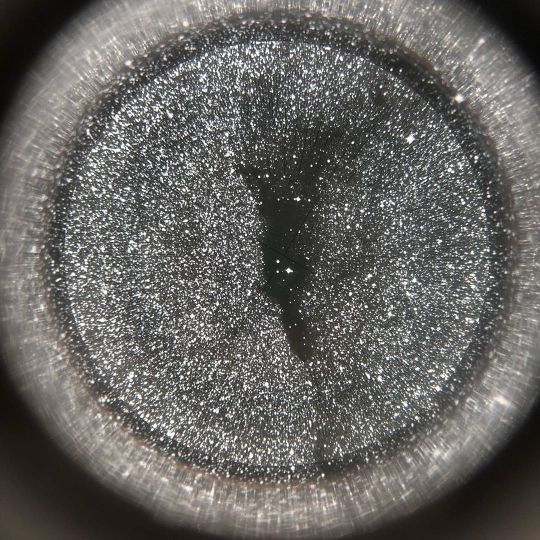
Had a wonderful visit to University College London Observatory at Mill Hill yesterday with @lumen_london and colleagues. They have an impressive group of telescopes- old and new- including the 19th cent Fry telescope with beautiful brass fittings and a weight driven tracking system. Too cloudy to observe the sky but we gazed into a glass photo plate of the Milky Way. Thanks to Mark Fuller and colleague Theo for the tour. We’ll be back! . . . #milkyway #telescopes #historicobservatory #stargazing #refractingtelescope #uclobservatory #artscience #artistslovestargazing https://www.instagram.com/p/B6DHDoglhnj/?igshid=hv0nd68a66rd
#milkyway#telescopes#historicobservatory#stargazing#refractingtelescope#uclobservatory#artscience#artistslovestargazing
0 notes
Text
Searching the Sky: Unravelling Perception
Perception has always fascinated me – aged nine I won a prize at the school science fair for two experiments on vision: colour detected in peripheral vision (what colour do we see first?) and the blind spot in the eye causing objects to disappear due to the entry of the optic nerve on the retina. My science career went downhill from there (defeated by lack of talent for math) and I found a better use of a burgeoning interest in optical phenomena in design later, and more fully, as an artist. Nature is ordered yet cleverly deviant: we must be alert to aberrations in patterns signalling new information.
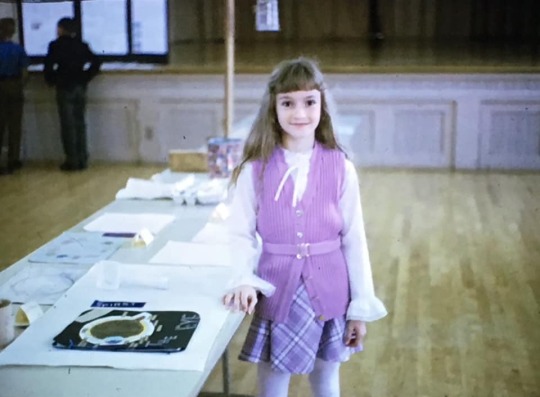
Aged 9, winning the science fair with two experiments on perception
Alongside my research into the Euclid Mission and the development of the VIS (Visible Light Spectrum) instrument at MSSL, I have been investigating the nature of perception as a psychological and philosophical question. Euclid will peer deeper into space than ever before, recording millions of galaxies and giving us the opportunity to answer fundamental questions about matter and gravity on a cosmological scale. My interest lies in how perception, filtered through sophisticated instruments and scientific intention, comes to be constructed in the mind and influences our grasp of reality. What historical baggage do we bring to the process of perception and could our understanding of space require a shift in perception to accept the extraordinary view being offered by a plurality of satellites and probes exploring the universe?
I discovered the work of Maurice Merleau-Ponty who, in 1945, wrote Phenomenology of Perception where he ‘emphasised the body as the primary site of knowing the world’ which couldn’t be separated from consciousness. His essay Eye and Mind focuses on aesthetic perception while also measuring qualities of the scientific gaze. As a compliment to this view, I found the writing of physicist and philosopher David Bohm useful in clearly outlining early 20th century behavioural research by Jean Piaget into a human infant’s awareness of space and itself while gracefully linking this to the relativistic view of the world established by Einstein in modern physics. He believed science must be open to the free play of creative thought by holding multiple theories at once, sparking one off the other until enlightenment takes place. This will be crucial if we are to expect a breakthrough in the current impasse in science, proposing that 95% of the universe is missing owing to the presence of dark matter and dark energy. Perspective is an essential part of perception.
Extending our sense of sight, through technological interventions such as the Euclid telescope, into previously unseen corners of the universe should result in a fresh understanding of the elusive structure of dark matter. Mapping three quarters of the universe (a gift to astronomers but baffling to the average man), it will produce 100 gigabytes of data per day, discovering a million new galaxies every 10 minutes before being calibrated, compressed and downloaded to earth for analysis. But will data analysis be enough? Bohm said:
‘The ability to perceive or think differently is more important than the knowledge gained.’ David Bohm
In the Eye and Mind, Merleau-Ponty says ‘It is by lending his body to the world that the artist changes the world into paintings’, meaning that through embodying sensations the artist finds a symbolic way to leave his vision in the world. By living in a body, not separate from the mind, he can weave a comprehension of the sensory rooted in his environment. Descartes wanted to place the mind away from the body but Merleau-Ponty saw that perception entwined the two – there is an ‘undividedness of the sensing and the sensed’ that unifies thought and sensation. However, the eyes see, take in the world, before thoughts emerge, and vision precedes analysis. Merleau-Ponty suggests that science must return to the original state of sensory experience – not the body as ‘an information machine’– in order to properly ground thought. He states ‘science manipulates things and gives up living in them.’
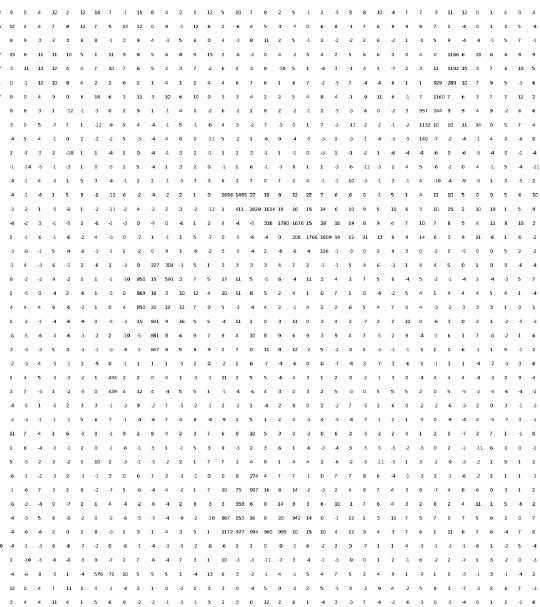
Sample Euclid data showing detected light levels of galaxies and cosmic rays etc as represented in numbers
While studying how the ultra sensitive VIS instrument will capture the delicate light from distant galaxies, it occurred to me that scientists no longer see these images with wonder. Streaming across the 36 CCDs of the naked focal plane of the telescope, these ancient photons are crucial data recorded numerically as light levels that will identify faint galaxies. Abstractly quite beautiful, as a numerical patterned field, this data spews from the system at 56 mega bits per second producing the equivalent of a football field of A4 sheets of data (see image). Galaxies, cosmic rays, stars and other ‘noise’ are recorded but then calibrated (or cleaned up) by ground stations making it ready for analysis. The wonder scientists experience is more likely bound up in the quantity and accuracy of the data. Perhaps this touches the core reason of why philosophers, poets and artists are valuable assets to such research. Marrying with science with sensation, they can create the ultimate visual experience where knowledge and feeling merge.
David Bohm understood the perceptual experience as a two-way process called a ‘circular reflex’. He carefully studied the research of psychologist Jean Piaget who, in the 1930s, looked at the cognitive developmental of infants, explaining perception as incoming reception of sensory experience complemented by outgoing impulses of action. The infant progressively builds up a mental map of the world by testing incoming perceptions (sight, sound, touch etc) through active impulses that meet with its environment in a constant feedback loop. There are ‘invariant’ objects forming expectations of the world (stored in memory) and these are adjusted as fresh information arrives. Incoming sensory information is placed on a mental map establishing a perceptual field of constant, stable objects (such as ‘six chairs sit upright on the floor’). This background field is challenged by inconstant information (such as a chair has fallen over). Forming our sense of reality, this process stimulates the intellect to form abstractions of these relationships such as mathematical laws describing, for example, the moment where gravity tipped the chair over. Everything is measured by what has gone before so naturally perception as a whole can become quite fixed.
Bohm goes on to say that ‘scientific investigation is basically a mode of extending our perception of the world, and not mainly a mode of obtaining knowledge about it’. Knowledge is the information that streams back into the feedback loop of perception – it is a higher-level abstraction of first hand experience. Astronomical instruments have the ability to extend our sense of perception by circumventing immediate experience and depositing additional (unsensed) information on our understanding of reality, thus creating expanded concepts of the structure and form of the natural world. The enormous quantity of data collected by Euclid may mean that it is possible no human will ever see all of the millions of galaxies detected on its mission. They will only exist as data. Through technology, information extends beyond man’s ability to sense it.
Yet Bohm is positive about this impasse. He believes the flexibility of the mind can overcome any fixed ideas by following curiosity in probing the perceptual structure of the world for falsities that hold us back. He mentions the ‘inner show’ of experience that plays back in the mind, and through imagination and memory creates hypotheses of meaning about the world. In early childhood, we are attuned to our environment in a flowing cycle of observation and experimentation that quickly grasps and then releases new thoughts and sensations. This process becomes habitual in later years as the general structure of the world is taken for granted. But, he says, if we are alert we sense contradictions when they arise. When this happens the brain is sensitive to the discovery of new relationships, leading spontaneously to further hypotheses, which are embodied in the appearance of new structures of the ‘inner show’. It seems relevant to describe here the shift in imagination I experienced while taking in the concept of the web-like structure scientists describe as dark matter in space. My inner show has been irrevocably altered and I no longer see space as an empty void.
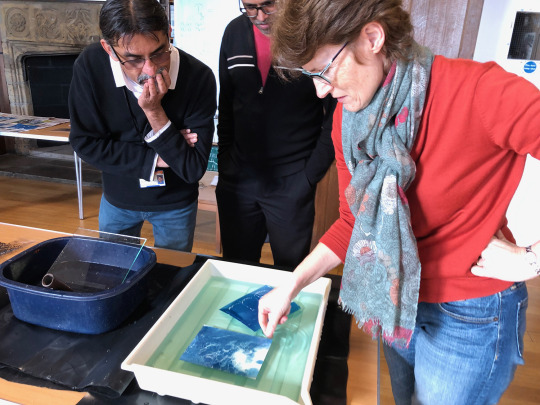
Cyanotype workshop at MSSL Space lab: eyes, hands, curiosity
To conclude this brief philosophical journey, one thing has become apparent to me during this residency: the sensory is still essential to scientific endeavours and artists can share expert skills in this area. Many of the creative workshops I held with staff used extremely tactile materials to express aspects of their work such as galaxy shapes in glass granules or paper to bend into curves forming new spaces within. Visual stimulation took many forms during these sessions – photo printing, drawing, watercolours, a camera obscura in a dark room and a walk in the woods. Strangely, few were interested in the stargazing activities on offer. However, my core followers at the lab are curious how I will react to their important work. I’m eager to share the exhibition artworks that respond to all that I have encountered at the lab – staff will be able to assimilate fresh visions, perhaps merging with their own ‘inner shows’ describing the universe.
Bibliography:
Merleau-Ponty, Maurice, (1962) Phenomenology of Perception. London. Routledge & Kegan Paul Ltd
The Eye and Mind (L’oeil et l’esprit) was the last work of Merleau-Ponty saw published. It appeared in the inaugural issue of Art de Frana, no.1, January 1961. Available at: http://www.biolinguagem.com/ling_cog_cult/merleauponty_1964_eyeandmind.pdf
Carman, Tony and Hansen, Mark B. N. editors, (2005) The Cambridge Companion to Merleau-Ponty. Cambridge, Cambridge University Press
Nichol, Lee, (2003) The Essential David Bohm: edited by Lee Nichol. London, Routledge
Bohm, David and Peat, David, (1987) Science, Order and Creativity. Routedge, Abingdon
Hoffman, Roald and Boyd Whyte, Iain, (2011) Beyond the Finite: The Sublime in Art and Science. Oxford University Press, New York
0 notes
Text
Celestial Landscapes
While at Ochre Print Studio, I began working with my old Iceland landscape images while developing a new print. Why do these scenes continue to hold my imagination? They look alien, barren, primitive but full of potential. Perhaps they reveal our planet as it looked at an earlier stage in its development when it was just a rocky place, before life took hold. Similar to moonscapes, these are places where we can imagine ourselves walking, collecting rocks and pondering distant mountains. We can envision a moment in time before humans cluttered the horizon with buildings and roads and re-imagine how we would have stood in relation to virtually untouched surroundings. I’d like to visit a vast desert like Death Valley in California for the same reason.
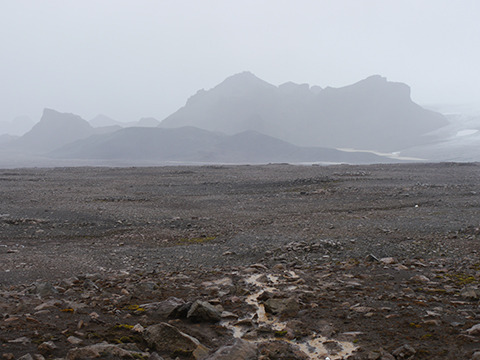
Iceland glacial rubble scene 2016
Thoughts are growing about the installation I feel compelled to construct for the end of residency exhibition in a few months. I’m thinking of juxtaposing three different landscapes – rocky earth (or wide ocean), a moon landscape and the Flagship Mock Galaxy pattern (ESA’s model universe). These images would be applied to large pieces of curved glass and hung in swathes of white mesh forming perfectly fitted arcs swooping through the central space of the Crypt. The presence of gravity is indicated by the graceful curved shapes that cradle (and apparently form) the landscape images through gathered material – analogous to the forming of the genesis of the universe. Theories from astrophysicists suggest we compose new stellar landscapes in our minds that locate us in a web of cosmic material (both visible and invisible) with structure, energy and tension. They tell us that dark energy and dark matter orchestrate the simultaneous clumping and expansion of star stuff resulting in a folding and unravelling universe. This novel landscape is best described by the Flagship Mock Galaxy where, after the big bang, the fundamental particles of the universe were evenly dispersed before they began to collide, stick together and gradually form a textured pattern of matter. Scientists think that in dense areas of this pattern, galaxies were formed and shaped by invisible dark matter and its intense gravitational forces. The abundant light emanating from these areas make up the star strewn universe we know where the nuclear reactions within their cores generate heat and light. Our star (the sun) is part of this spray of light.
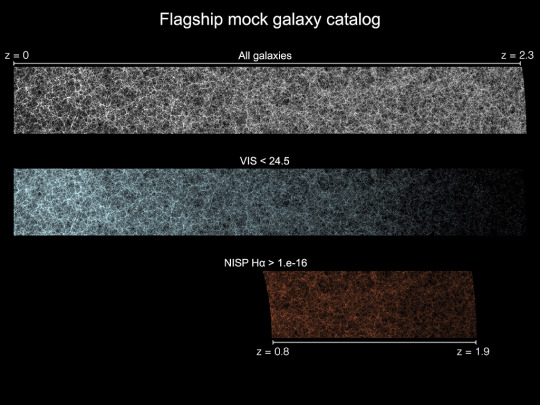
In order to test the Euclid instruments for data processing, a synthetic cosmological simulation that matches the expected volume and complexity of real data showing the evolution of the universe (left side is current evolution and right is soon after the big bang).
My brief residency with Lumen London and Mayes Creative on the Lizard peninsula yielded an ideal setting to gather photos to suit my purposes. The vast, sparkling ocean reminded me that cosmic light constantly bathes us in particles from the universe. Earth is a rocky planet yet bodies of water make it distinctive, reflecting back our blue sphere into the darkness of space. Visual perception has evolved around the presence of light – it’s safe to say there would be no art without light.

Lizard Point, Cornwall 2019
On reflection this piece may also be about the weaving of forces and light seen through the stretch of white translucent fabric holding the images. It also refers to the rays of visible light recorded by the Euclid VIS instrument telescope – through layers of calibration (up to 20 adjustments) photon impulses reach us in the form of data that can be assembled into images or simply used for spectral analysis. In addition, I’m considering placing square blue mirrors underneath each arc of glass as an acknowledgement of the 36 highly reflective CCDs that make up the focal plane of the instrument, collecting these crucial photons of light.
Here are some of the first screen printed glass panels being fired in the kiln and a video showing a sample of the installation.

vimeo
0 notes
Text
Touching Space
After a few casual conversations with Tom Kitching (MSSL Astrophysicist and Euclid Science Lead) last winter, an exciting project was finally executed at the Euclid 2019 Meeting in Helsinki 4-7 June. I had queried whether it was possible to place something on the spacecraft that reflected on the humanity who had made it. He agreed that the telescope is an angular, technical looking object that doesn’t necessarily convey anything about the ‘soft’ aspects of astrophysics: human curiosity, need to communicate, and our urgent need to explore deeper and deeper into the cosmos. If ‘someone’ found the craft in years to come, well after it’s predicted six year lifespan, what would it say about the humans who made it?
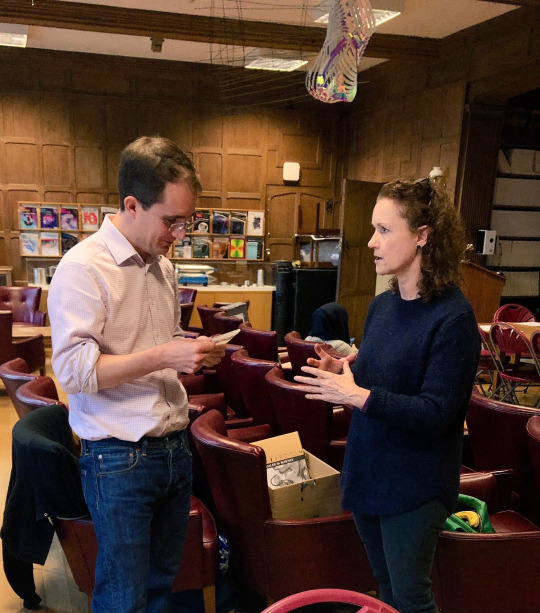
The idea gathered momentum within the Euclid team so he encouraged me to ask the people in charge at ESA, during my visit in January 2018, if they would be open to a proposal for an ‘aesthetic intervention’ on the spacecraft. At that point I invited Tom to collaborate with me on the project, feeling it would have better support from ESA with his involvement. However, equally important, by combining our varied skills, surely more exciting and well-considered ideas might emerge. What a wonderful thing, to brainstorm with an astrophysicist.
ESA were surprisingly positive about the proposition so we got together for a few thinking sessions over the next few months. Setting out the criteria wasn’t as easy as I imagined. Who was our audience, what were we trying to communicate? Could it be poetry, drawing, an event or reflect life on earth? How do we represent the huge collective effort of the international mission team? Deciding that it should be visual, include a galaxy (Euclid is a galaxy hunter) and possibly be collaborative helped. We considered how mankind has always left its mark on the environment and cave paintings came to mind. After one intense brainstorming session it just seemed to pop out at us – a large collaborative fingertip painting of a spiral galaxy.
I wrote up an initial proposal and got to work planning a test session at the lab to see how the idea might work. Materials were explored in my studio and Tom gave the proposal a more refined approach, including well-written selling points such as ‘provide the Euclid community with a tangible, and personal relationship with spacecraft’. On 22 May I ran a creative session at the lab with about 20 people joining in the fun of finger painting… and it was really fun, and noticeably, enthusiasm was building about the idea. I provided an image of M51 The whirlpool Galaxy as an example. At half the intended size, small improvements could be made to achieve a larger, better version but the shape (guided by light pencil marks) emerged quite easily and would condense well if reduced. There was a surge of hope. I felt his could really work and successfully represent the spirit of the Euclid Mission – each fingerprint seemed to carry the energy of its contributor.
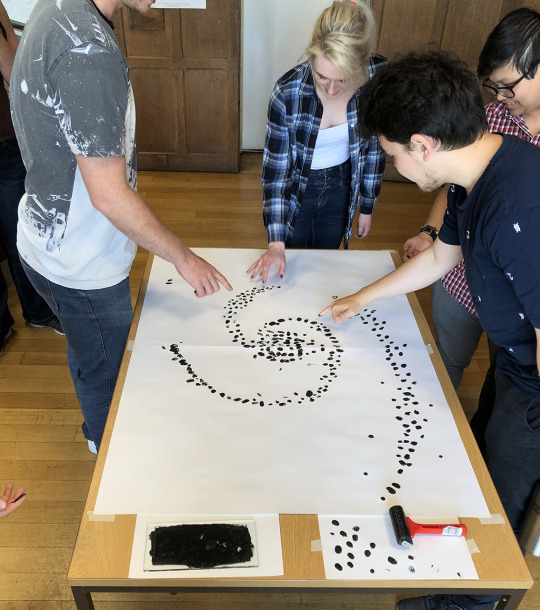
Using the images from the taster session to illustrate the proposal, we finalised the text and sent it off to Giuseppe Racca, Rene Laureijs and the Euclid Science Team only a week before the Euclid Consortium meeting where we proposed it should be made. I didn’t want them to feel pushed into a corner but in hindsight the momentum worked for us.
Tom had arranged for me to attend the conference and the lab covered the expenses – I hadn’t budgeted for this in my Arts Council England grant. Sam (my filmmaking son and assistant) insisted I film the workshop so he tutored me on the equipment and we bought an extra tripod for a still camera to record the progression of the painting. What a lot I had to carry… and think about. I was invited to speak at the Thursday plenary session about the intersection of art and science and the residency at MSSL. More to prepare during an unusually busy time that included designing a poster for my brother and attending to the set up of two exhibitions in London.
I had to get up at 4am to make the flight but setting up the afternoon before the workshop seemed wise. The Finlandia Hall was wonderful (designed by modernist architect Alvar Aalto) and had plenty of space. The spacious lobby and coat check had ample room at one end to set up cameras, a double sized table for our A0 paper, a cleaning area with sponges for dirty fingers and an easily wiped stone tiled floor. I had two glass tiles to spread the pre-prepared paint on and the drawing was securely taped to the table. But could I get participants to take part when they were on the floors above?
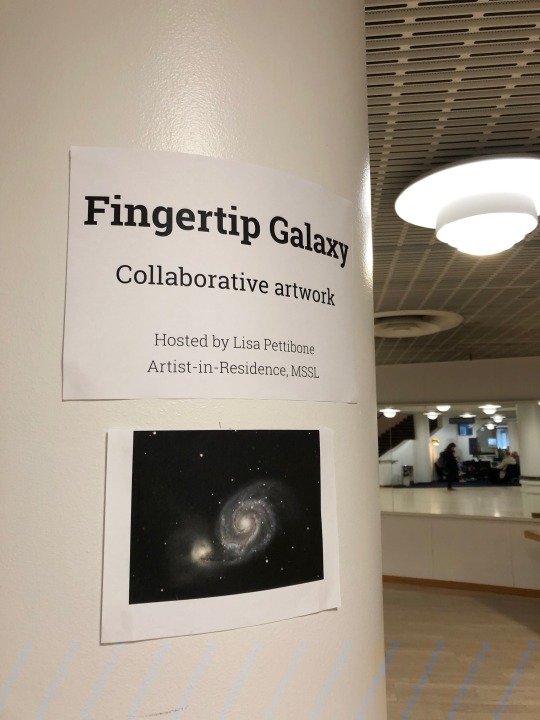
By 8.30am the next morning (scientists start earlier than artists) I was making final preparations and began my enthusiastic overtures to snag participants and begin filming. It was such a high-energy day and gradually the painting gained momentum: at first reluctant, the attendees dribbled in then, by 2pm, and a few announcements, there were crowds around the table and an infectious, jolly atmosphere prevailed. Although I explained how to make the marks, it was fascinating to see their reactions to paint: some wanted to make lots of marks, some noticeably enjoyed the feel of the paint and others took a few minutes to decide where to press their finger. I think all of them were smiling when they left the table.
Juggling intereacting with people and filming used every bit of available energy I had. I haven’t worked that hard in a long time. It’s possible that at least 250 people contributed to the artwork. By late morning Giuseppe Racca confirmed that they would find a place for it on the Euclid Mission my smile became permanent. Also, the news motivated more people to take part, making the image fuller in detail and texture. It’s a human emotion to desire your mark be left in space and not many get the chance.
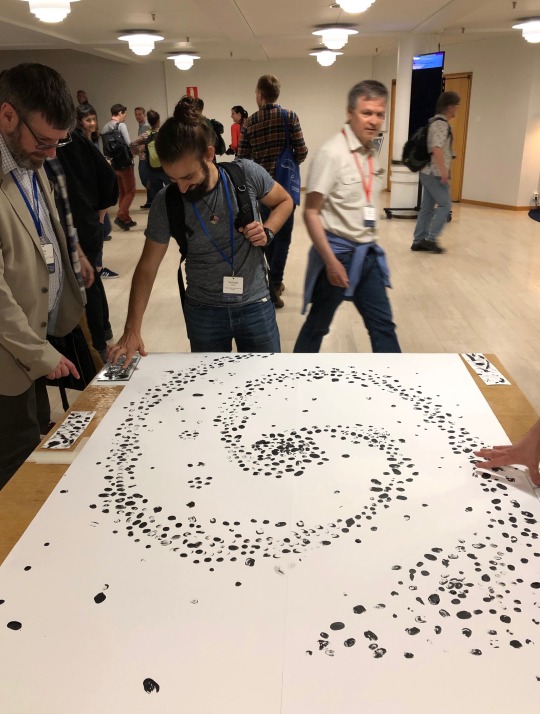
I’ve now taken the artwork back to MSSL for the team there to contribute to, fortunately Sam was around to film it this time. It will be photographed and photo-shopped to create the graphic artwork for etching on to the satellite. Also at the next stage, Tom will encode it (like a QR code) and we’ll discuss what the link information will be (will aliens read this or just curious humans?). ESA will confirm later where it will be placed but there are a few ideas being mooted already. I’ll enjoy seeing how the film comes together – I’ll get in touch with the communications team at ESA and discuss how it might be used. It would be amazing to go to Italy to see it being applied to the spacecraft – a hope to far?
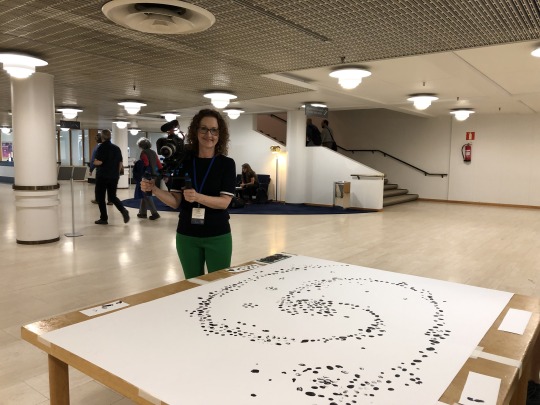
0 notes
Text
Sensing
A few months ago big news hit the astronomy world – the first ever image of a black hole was captured by an array of nine telescopes from across the world. PhD student Katie Bouman in the US had created a unique algorithm combining complex image data to ‘see’ the shape and colour of this cosmic event. It was thrilling news and I was mesmerised by the photo – but something more than the scientific significance of this achievement had occurred. As someone who is observing a space science institution in the course of my residency at MSSL, and grappling with my place as an artist in their world, I realised that a threshold of perception had been crossed. Black holes have been understood and described through mathematics since Einstein first proposed their existence, but here they have been transformed into a sensory experience we can all share and wrap our minds around. The sensory is crucial in transcending scientific knowledge.
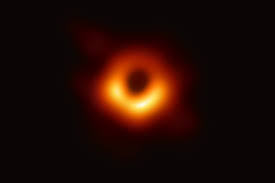
This thinking nudged a realisation that perhaps this is what I’m try to accomplish through my work – aligning human sensation with emerging cosmology in an effort to ‘touch’ difficult to imagine concepts at the core of our existence. I’ve been investigating the nature of perception, and the process of perceiving itself. Artwork is a way of filtering this information through the tactile qualities of materials, visually rich imagery and philosophy that question how paradigms of thought are constructed. I’ve been reading Merleau-Ponty Phenomenology of Perception and exploring the ideas of Kant and Heidegger relating to technology and science. Merleau-Ponty stated that ‘the body is the primary site of knowing the world’. Artists are in a unique position to bridge the body and mind through acknowledging sensation in visual, tactile, sonic and spatial relationships.
Back to the lab... I provided two sensory related workshops this month. I invited artist and photographer Olga Suchanova to collaborate on a pinhole camera session and we also built a camera obscura in a meeting room on the same day. There was something poetic about using primitive photographic processes in a place where staff are developing extremely sensitive telescopic instruments. Constructed in paper and Tate Gallery soft drink cans, the pinhole cameras made them think about light in a more immediate way. Where to place them, how much light is needed to sensitise the paper inside, and what sort of image can be produced were all explored. The crossover between creative play and dedicated testing became apparent as a few participants developed several photos to achieve the result they wanted. We fashioned a little dark room in a storage cupboard adding to the experimental feel of the day. In the red tinged darkness, watching the image emerge slowly in the developer is still exciting even to scientists.



It took an hour and a half to make the camera obsura: blocking all the light from the window and door, making a small hole for the light to pour through, arranging white boards to catch the daylight. Why is the result so magical? As I took small groups or individuals up to the converted meeting room, I had to ask myself about the worthiness of the experience. Standing in the room, letting our eyes adjust in the quiet, then marvelling at the flipped image of trees and sky, it came to me. We are seeing ourselves seeing – acutely aware of this faculty of consciousness. We take for granted the human quality of sight and by slowing down the process, our relationship with the visual world is emphasised in a sublime moment. The Euclid telescope will detect the most distant galaxies known to man yet we will see this light second hand through calibrated and transmitted data – how does this compare with the immediacy of a stream of photons observed in our makeshift camera obscura room? I’d say the physical, live experience is greater as it is observed over time, with anticipation in a dark space and with others sharing the experience. We could hear the birds outside and feel our eyesight sharpening as we noticed the detail and movement in the trees. The fullness of the senses is something to believe in.

0 notes
Text
Emerging ideas
A few weeks ago while swimming (often this activity stimulates random creative thoughts) I noticed that the light shimmering on the bottom of the pool was in fact just a reflection of the shape of the water above me. The interaction of light and form has been an ongoing fascination but my interest has intensified since studying phenomena in physics. Dark matter doesn’t interact with light or other matter (like the stuff we are made of) but it has gravity like all matter. The gravity of large cosmic objects can bend light and in astrophysics stretched arcs of light from distant galaxies are defined as gravitational lensing. The light from galaxies can be distorted into smeary banana-shaped curves by the presence of dark matter in between us (the viewer) and the galaxy. We are looking at an illusion or aberration of a cosmic object, not the real thing, that may have a more ‘galaxy-like shape’. Spotting these distortions are important in the search of dark matter – illusions can find truth.
Back to the light in the pool. Projecting intense light through glass will project curious shapes of light on a surface. Have you ever seen rain water on your window projecting watery patterns on a wall opposite during the daytime? I imagined shining light through rippled glass to build overlapping surfaces that record the transparent shapes and throw the scattered light on to a projection screen. Using my glass slumping (bending) techniques, I played with the possibilities of this idea by re-slumping an old piece of work (languishing in a box). The piece had gold lustred dots across its puckered surface and was quite thick (6mm) so I stood it upright between two kiln shelves to collapse in a three-stage firing. The results produced an object perfect for projecting a strong LED through. The patterns were fascinating and could be changed by moving the glass. The shapes and patterns have travelled across and through the bent layers of glass, forming fabric-like patterns on white card opposite. The correlation with gravitational lensing was exciting. Developing this further, perhaps into a large, moving light projection in a dark room, seems a tantalising project.

Other work this week included lustering two black glass pieces with tiny platinum dots (a section of a fictitious universe) and slumping it to form bumps and bends. The two panels were meant to fall and mingle into a flowing shape in the kiln but I didn’t judge the temperature correctly – often it’s guesswork – and it fell too far. However, I observed this in action and found that at 10 degrees cooler (785c) the shape was stronger. Luckily I photographed the first stage and the distortions were excellent... perhaps that has more possibilities.

An encouraging collaboration has begun with the MSSL workshop. I approached Simon (the manager) about using one of their CNC machines to carve a grid-like master mould for me to use to make a ceramic mould. Fortunately he seemed amenable so I bought some thick acrylic and sent him a drawing for the measurements. Waiting to progress this week but it builds on an idea I tested two years ago with small slip cast trays full of glass frit. The approach now seems ripe for resurrecting as a way to ‘map’ forces – terminology used by Euclid describing how it will map the geometry of three-quarters of the galaxies in the universe. The Euclid data will locate size, shape and relative depth of billions of galaxies that they think will reveal where dark matter is invisibly forming matter into their distinctive shapes. I’ve used fused glass grids to map the forces of gravity and heat to form a series of pieces. And now I want to use this on a bigger scale so the precise master mould they can help me with will be invaluable. I hope to take this production to The Glass Hub where I can whip the glass grids out of their moulds and do some hand-manipulation with the hot glass. I need help and their heat safe equipment to do this... they sound game but I’ve got to find funding.

The other exciting development resulting from my visit to ESA (European Space Agency), is a collaboration with Tom Kitching to make an aesthetic intervention on the Euclid space craft. We had talked about this possibility a few times – something nonfunctioning that expressed the spirit of the project. Supported by Tom, I asked both Guiseppe Racca and Rene Laureijs (ESA Euclid managers) if they would consider the proposal. Wonderfully open to this unexpected query, they had no objections. It would be extremely exciting to send a creative work into space. Tom and I have had initial discussions and will now include instrument scientist Ruyman Assolini in the development and aim to present ideas in May to ESA and then to the Euclid conference in Helsinki which I’ll attend in early June.
Something else on the horizon is making a sculpture in the large clean room where they are busy testing the Euclid components. While we were filming there in February I asked Alastair, who manages the room, and he provisionally agreed. I’ll have to wait until April when it is less busy for the team but it will give me time to plan what I want to make. The material I’ll use is the thick space foil I see used in all the labs but it will have to be the ultra-clean type used in Level 3 labs. For me the desire is to produce work in the unique environment similar to space crafts, which are normally bereft of art objects. I believe art can co-exist with science and may benefit the wellbeing of the staff.
0 notes
Text
Two way exploration
There was a second session of cyanotype printing at the lab about 3 weeks ago and I realised something interesting about these workshops dealing with data: the staff are asking each other about their work and explaining the data to each other. These sessions have become a place where scientists, engineers and programmers mix and talk outside their normal teams. In each workshop I’ve tried to include an element of familiarity such as ‘data’ as a springboard to creative thinking. Hopefully they see their work in a new way and refresh their perspective on its value. There are other unexpected outcomes too. By planning and taking part in these sessions I am developing my own work along the way. For instance as an artist, I’ve been interested in the presentation of data - some of it is quite beautiful in the line quality particular. It’s allowed me to think about layering this aesthetic with other imagery (my own photos of nature) to achieve a richer meaning. During and after the cyanotype workshops I’ve worked into these emerging ideas and I’m now considering developing a series of cyanotypes as part of my final work. I didn’t expect the workshops themselves to become a point of inspiration. I’ll post more about this next time.

0 notes
Text
Settling In/ESA Trip
It was around mid December when I was invited to join the MSSL Christmas lunch, that I began to embedded in the residency. I had come to speak with one of two Euclid staff and was swept up in their seasonal meal crammed into the common room with about 200 people. Paper airplanes joyously zipped around the room like uni students whipping up a good time. Squished between a few physicists and engineers, conversation was lively and casual as other staff generously became our servers. Later I visited the electrical engineer’s lab where Anand let me carefully enter to view some beautiful pcb boards being tested with an array of equipment. He pointed out the video output on screen where a vibrant tapestry of colour displays the fine pathways of electrical flow. The boards themselves are stunning. Incredibly intricate, they resemble a birds-eye view of brown desert scene where buildings and cars are carefully lined up. They will go from his station to eventually be coated (sealed) in France and there was a certain urgency about the work – the schedule was tight.

Electrical board that will process the CCD data from the Euclid instrument
Although I sometimes speak to people in their offices or labs, I’m getting used to setting up in the common room where meetings seem more relaxed and without other colleagues close by, conversations can become quite revelatory. Not gossipy but I learn more about the individual which somehow puts the whole project in a better context. Initially I ask about their role in the team but then ask them how they have arrived at MSSL to learn about background and personal interests. I think this approach, and seeing them around the lab frequently mean (including those who have attended the workshops) we are all getting to know each other. I noticed that more of the Euclid team are joining in which is really satisfying. Next week I’m repeating the Cyanotype Data/Nature session as some were just getting the hang of it and weren’t able to bring data of their own. However, new people that missed the last one have confirmed they are attending and sent interesting data file for me to print out.
Finally I spoke to Mark Cropper (Instrument Manager) and Tom Kitching (Science Lead), with similar queries, but also focussing on their thoughts about the legacy Euclid will leave for astronomy, cosmology and mankind. I’m beginning to understand the significance of this – the mission will contribute significantly to the way culture speaks about and visualises space. Instead of referring to the void as a black empty space interrupted by stars, we’ll eventually talk about the structure of space as dark matter is included in the public lexicon.
I posed these questions to the primary managers of the mission at the ESA last week – yes I was invited to meet them and tour the test centres! Both René Laureijs (science manager) and Giuseppe Racca (overall manager) were incredibly generous with their time and I spent over an hour with each of them. They were willing to discuss questions regarding legacy and were unexpectedly philosophical about the breadth of the mission’s reach for physics (Einstein’s theories on gravity could be clarified or dismissed) and something unexpected could be revealed about the early universe when dark matter was emerging. Always interested in materials, I asked Giuseppe if he had a sample of silicon carbide (most of the craft’s structure is made of this) and, wonderfully, he did. It was a pleasure to handle the charcoal grey stuff and discuss how they bake (sinter it) forming a type of ceramic. It is so hard it can be mirror polished. He also showed me detailed 3D rendered images of the inside of the pay load base plate housing the instruments. All the conversations with the team in Surrey really came together as and I found I could discuss many elements. Greedy for photos I snapped his screen images.

3D rendering of Euclid interior

Small Euclid model in Giuseppe Racca’s office
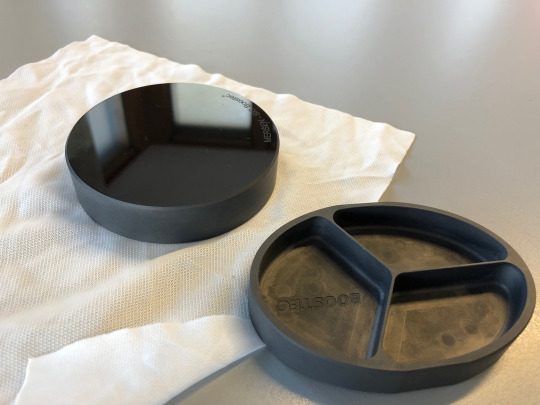
Samples of silicon Carbide used in the instrument structure
Earlier in the day I was asked to prepare a breakfast presentation with cross section of staff in a small common room. It’s safe to say they don’t get many artists sharing their work in this context. I spoke about my art practice for about 12 minutes then described the residency at MSSL and my aims there as an artist. Luckily Sam (filmmaker) had edited together a 4 minute video of three workshops and sent it to me the night before. It was a perfect illustration of my involvement with the MSSL staff. Claudia Mignone (Cosmologist on ESA Communications team), who organised the 1.5 days activities, had generously arranged a lunch near the canteen inviting the breakfast group and Euclid team members. She let me linger in the hallways to take in the mission displays too.

ESA entrance hallway

Me with the 3D printed moon material block
One of the displays showed the technology being developed for a proposed Lunar Base aka The Moon Village. A large 3D printer had created a kind of building block sample from simulated regolith (moon dust). I was extremely interested in this and felt lucky to see it – I’m currently on the Moon Village UK Committee and trying to support the international effort to achieve this monumental task. Claudia was able to organise a meeting with the ESA astrophysicist and MVA supporter Bernhard Foing who informed me about various international activities afoot on this subject, including artists and students. What a revelation there was so much going on throughout Europe including the EuroMoonMars group and an exhibition called The Moon Gallery at Space Expo just down the road. The UK seemed behind the curve as I told him about the MVA’s involvement with The Moon Festival in London this summer where I may run workshops.

Model exploring the Moon Village concept
Claudia had time to speak to me about ESA’s Cosmic Vision space research programme. The Euclid Mission is a medium class mission exploring the dark universe and others are planned such as the Solar Orbiter and the Plato Mission that will study a large number of extrasolar planetary systems. I was also happy to meet her colleague Karen O’Flaherty (Science Coordination Office) who was interested in the MSSL Residency and how it was set up. The ESA had an artist in residence about a year ago and perhaps they are planning another initiative so she was keen to compare notes. How fortunate I was to meet all these people!
And how is this research affecting my creative process? The next blog will explore the beginnings of artworks and ideas.

Recovered Hubble Telescope panel with tiny micro-meteorite holes
0 notes
Text
Nature/Data/Nature/Data
On Friday I completed the 3rd creative workshop at MSSL making cyanotype prints with curious staff. The idea to make use of data combined with imagery of nature and natural objects evolved over the past few months. When speaking to scientists and engineers across the Lab, I’m often presented with diagrams as they attempt to explain their work including diagrams and wave form data. The visual qualities are quite interesting, especially the rhythmic patterns. It occurred to me that this is another way of ‘seeing’ nature and it would be a nice experiment to juxtapose these two interpretations. So I set about asking a few staff for examples of the sort of data they see everyday, in mainly graphic, line based form so I could scan it and create black and white acetates on a laser printer. Many were happy to indulge my mainly aesthetic requests and secretly I was pleased to find a way to work together.
Later, I went through personal photos (many from other art projects) that lent themselves to the idea such as clouds, vistas, underwater scenes that have enough light areas to overlay with data. After some experimenting with these and exposure times, I thought it could work. Indeed, on the day, it sparked imaginations and there were some wonderful results. Best of all I noted the enthusiasm for spontaneous ‘making’ and plan to help them develop this further by repeating the session in a few weeks. I was keen to see how detached they could be from their normal encounters with data and if it would prompt new impressions of their work as an element in art making. I was surprised at how easily they let go of the formal qualities and grasped the material qualities such as layering, shape and contrast. This was super satisfying hence the need to repeat the session.
In terms of my work, the immediacy of the cyanotype process (essentially a contact print photographic process using photo sensitive chemicals brushed on paper) sparked ideas for me too and I went back into my studio to do more later in the day. Light vs dark is such a strong theme for me (and for this residency) that I can quickly access ideas about materials and relationships without much planning. I’m always in a better position creatively when I can react to materials.

On Friday I completed the 3rd creative workshop at MSSL making cyanotype prints with curious staff. The idea to make use of data combined with imagery of nature and natural objects evolved over the past few months. When speaking to scientists and engineers across the Lab, I’m often presented with diagrams as they attempt to explain their work including diagrams and wave form data. The visual qualities are quite interesting, especially the rhythmic patterns. It occurred to me that this is another way of ‘seeing’ nature and it would be a nice experiment to juxtapose these two interpretations. So I set about asking a few staff for examples of the sort of data they see everyday, in mainly graphic, line based form so I could scan it and create black and white acetates on a laser printer. Many were happy to indulge my mainly aesthetic requests and secretly I was pleased to find a way to work together.

Later, I went through personal photos (many from other art projects) that lent themselves to the idea such as clouds, vistas, underwater scenes that have enough light areas to overlay with data. After some experimenting with these and exposure times, I thought it could work. Indeed, on the day, it sparked imaginations and there were some wonderful results. Best of all I noted the enthusiasm for spontaneous ‘making’ and plan to help them develop this further by repeating the session in a few weeks. I was keen to see how detached they could be from their normal encounters with data and if it would prompt new impressions of their work as an element in art making. I was surprised at how easily they let go of the formal qualities and grasped the material qualities such as layering, shape and contrast. This was super satisfying hence the need to repeat the session.
In terms of my work, the immediacy of the cyanotype process (essentially a contact print photographic process using photo sensitive chemicals brushed on paper) sparked ideas for me too and I went back into my studio to do more later in the day. Light vs dark is such a strong theme for me (and for this residency) that I can quickly access ideas about materials and relationships without much planning. I’m always in a better position creatively when I can react to materials.



Other exciting news is that I’ll be visiting the European Space Agency (ESA) in the Netherlands on the 29 Jan. I’ve been invited to speak with three members of the Euclid Mission team as part of my research understanding the scope of the project. For months now I have been interviewing the MSSL team in Surrey learning about their roles in the making of this extraordinary instrument. Engineers, programmers and instrument scientists have given me a detailed understanding of the materials and processes that concern their work. I’m now longing to understand how the concept emerged at the ESA and how it fits with their overall aims. The search for dark matter and dark energy are hugely important subjects in contemporary physics and universities are proposing millions be spent on experiments to reveal their nature. Perhaps what I’m keen to know is how, in many years to come, our perception of the universe will be forever changed by this work. It has changed my internal concept of the void: it is filled with structure and gravitational tension where I thought nothing existed. Cosmologists speak of structure ‘bubbling up’ as the universe formed with matter coalescing in nodes of dark matter forming galaxies from clouds of dust and spent stars. When the data comes back from Euclid in a few years (launching in 2021) the words in our public lexicon, describing the cosmos, will change. The picture of the universe we carry around in our heads will be fundamentally transformed as when Hubble discovered that our galaxy is one of many millions. We live with blind spots about our existence, technology continues to shatter these but before we can absorb the information a new question emerges.
0 notes
Text
Stargazing, materials and shapes
Last Friday I co-hosted an Artist’s Stargazing evening at MSSL with the help of Guildford Astronomical Society, Tom Kitching and George Seabroke. Our group of 9 artists were treated to an intimate presentation explaining the Euclid and Gaia Missions and the work of GAS promoting astronomy locally. In two groups we were led up the hill behind the lab to a bijoux observatory where we saw a quivering view of Mars through the Holmbury telescope and learned about how the other telescope (in its own hut) is used for astral photography. Back in the dimmed light of the common room, I displayed ‘Remnants of Attraction’ on black glass and a refreshed dichroic hanging piece ‘Apeiron 2. My artist colleagues seemed captivated by all the elements of the evening and took in a surprising amount of knowledge about the universe. I had hoped MSSL staff would attend too but it proved harder to persuade them than the artists.

What I really want to talk about, however, emerging ideas about materials and shape from interviews with staff about their roles in the Euclid Mission. They are a mix of scientists and engineers, all with incredibly disciplined jobs to design, test and build components for this extremely powerful orbital telescope. The intensity of the testing is mind boggling. But what caught my imagination is how they employ robust, space-fit materials in the craft and how visual their test data is.
Ashraf, a mechanical engineer, introduced me to invar, a nickel/iron alloy that has a very low expansion rate so is stable in extreme temperature ranges. It is used to bolt components to the base plate that holds the instruments. I had never heard of this metal but I do understand the concept of co-efficiency as glass has a COE rating which identifies its compatibility with other glasses. For instance I can’t mix COE90 with COE96 art glasses or they’ll crack. Expansion and contraction of materials is extremely important in space where temps can swing from -200 degrees C to + 125 C.
Silicon carbide is an equally important material, as it extremely hard, resistant to thermal shock and has almost zero COE. The base plate for the Euclid telescope is made from this thus protecting the finely calibrated instruments from distortion. Also known as carborundum, I use this in a ground form to polish glass. It is referred to as a structural ceramic, I guess because it’s fired together to achieve its hardness.

I’ve also met Rahil, a firmware developer, who programs the interface for the Euclid CCD camera, and he showed me the little circuit boards he uses for testing in his lab. They use copper for wiring and connection points and create a lovely sheen on the surface. But more than that I was surprised how the data he looks at when testing creates pleasing linear patterns such as wave forms. Embedded in these wave-forms is information about the circuits (and possible errors). These can appear as raw numbers or pulled together in a diagrammatic form. I’m going to use some of these graphics in my next workshop using cyanotype photography where we’ll combine this data with images from nature hopefully creating curious juxtapositions of imagery.

0 notes